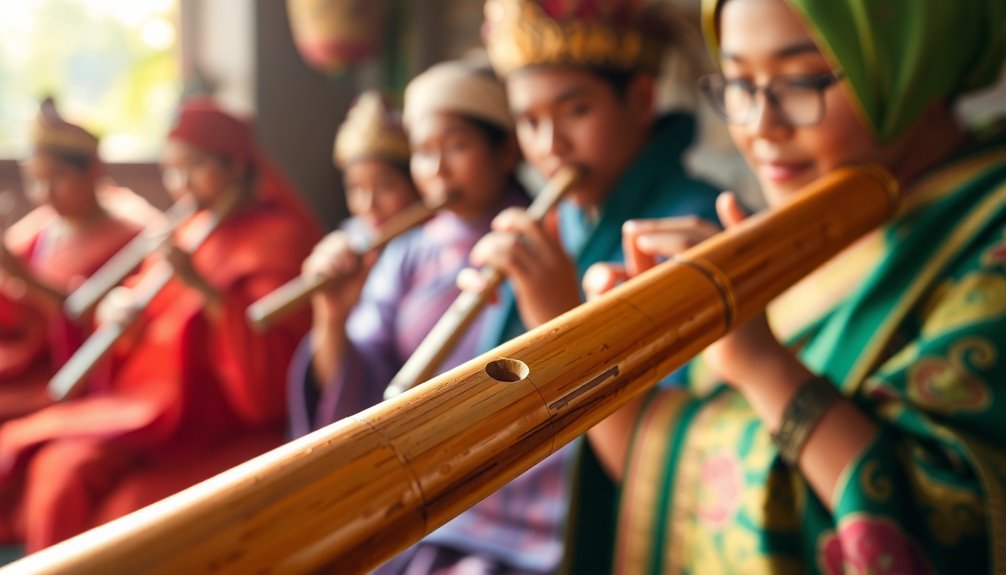Flute music weaves a rich tapestry across global cultures, each style reflecting its unique heritage. You'll find the soothing notes of the Native American flute, often symbolizing love and connection to nature. In India, the bansuri serves as a spiritual link through improvisational raga. The Chinese dizi enhances emotional expression, especially during festivals. Meanwhile, the Irish flute promotes community with infectious dance tunes. Andean flutes, like the siku, preserve indigenous histories. Across the Middle East, the ney evokes deep emotional narratives. Japanese shakuhachi fosters a meditative connection to nature. Explore these styles further to uncover their profound impacts.
Key Takeaways
- Native American flute music symbolizes cultural expression, healing, and connection to nature through soothing melodies that communicate with the spirit world.
- The Bansuri in Indian classical music allows personal storytelling and improvisation, embodying spiritual connection and enhancing the depth of Indian heritage.
- Chinese bamboo flutes like Dizi convey emotions and play a central role in festivals, enriching community participation and cultural heritage.
- The Irish flute connects history and emotion, creating infectious dance tunes that foster a sense of belonging among listeners.
- Andean folk music utilizes traditional flutes to preserve indigenous histories and values while engaging audiences in cultural narratives.
Native American Flute Music

In the world of traditional music, few instruments evoke as much emotion and connection as the Native American flute. This instrument, often made from wood or river cane, isn't just a musical tool; it's a vessel of cultural expression deeply rooted in Native American history. Each note you hear carries the weight of stories, traditions, and spiritual significance, reflecting the diverse tribes and their unique experiences.
The flute symbolizes various elements in Native American culture, including love, healing, and connection to nature. You might find yourself captivated by the soothing melodies that often serve as a means of communication with the spirit world or as a way to express feelings that words alone can't convey.
When you listen to a Native American flute, you're not just hearing music; you're tapping into a rich tapestry of history and emotion. As you explore this musical genre, you'll notice the intricate techniques used by flutists, who draw on their cultural heritage to create hauntingly beautiful sounds. The craftsmanship of these instruments, often made from high-quality woods, adds to their unique tonal qualities and durability.
Each performance is a personal journey, inviting you to connect with the broader community of those who cherish this art form. By embracing the Native American flute, you become part of a larger narrative, one that resonates with themes of unity and belonging. The music beckons you to reflect on your own experiences while appreciating the depth and significance embedded within each note.
Indian Classical Music

Indian classical music stands as a profound expression of cultural identity and artistic innovation, showcasing the flute as a pivotal instrument within its rich traditions. The Indian flute, known as the bansuri, isn't just a musical tool; it embodies a deep spiritual connection to the culture and history of India. Crafted from bamboo, this instrument produces a sound that resonates with the natural world, inviting listeners into a space of tranquility and reflection.
In the domain of Indian classical music, raga improvisation takes center stage. You'll find that every raga tells a story, evoking a specific mood or emotion. As a musician plays the bansuri, they weave intricate melodies that breathe life into these ragas, allowing personal expression to flourish.
The improvisational nature of raga performance means that no two renditions are ever the same, creating an intimate experience between the performer and the audience. When you listen to a bansuri performance, you're not just hearing music; you're participating in a centuries-old tradition that celebrates creativity and connection.
Each note you hear carries the weight of cultural history, inviting you to explore the depths of Indian heritage. The flute's ability to convey emotion and transcend language makes it an essential element of this art form. Additionally, the bansuri is often played in conjunction with raga improvisation, enhancing the depth and richness of the musical experience. So, as you immerse yourself in Indian classical music, let the haunting melodies of the bansuri guide you on a journey of discovery and belonging.
Chinese Bamboo Flute Traditions

The enchanting sounds of the Chinese bamboo flute, known as the dizi, transport listeners into the heart of China's cultural heritage. This traditional instrument, crafted from bamboo, plays a pivotal role in Chinese music, embodying the rich history and artistic expression of the nation.
As you explore the dizi, you'll discover its unique construction, featuring a membrane covering the blowing hole, which adds a bright, resonant quality to its sound.
The bamboo flute isn't just an instrument; it's a vessel of cultural significance. Rooted in ancient traditions, the dizi has been integral to various performances, from folk music to classical ensembles.
When you listen to a skilled musician, you can feel the emotions woven into each note, conveying stories of love, nature, and spirituality that resonate deeply within the listener.
In festivals and celebrations, the bamboo flute often takes center stage, inviting everyone to join in a shared experience. Its versatility allows it to adapt to different contexts, from lively dances to serene meditative pieces.
As you immerse yourself in this soundscape, you'll find an inviting sense of belonging, connecting with a culture that values harmony and community.
Understanding the Chinese bamboo flute's role in this rich tapestry enhances your appreciation for its music. By embracing the dizi's beauty, you're not only enjoying a melodic journey but also participating in a timeless tradition that bridges generations and unites diverse hearts. Additionally, the craftsmanship of the dizi, often made from aged bamboo, significantly influences its sound quality and overall performance.
Irish Traditional Music

While the dizi serves as a bridge to Chinese heritage, the lively rhythms and melodies of Irish traditional music evoke a different yet equally rich cultural landscape. At the heart of this vibrant tradition lies the Irish flute, an instrument that brings together history, emotion, and community. Crafted from wood or metal, the Irish flute has a distinct sound that resonates with the soul, allowing musicians to express the joys and sorrows of life.
When you listen to traditional jigs, you can't help but feel the pulse of the past. These infectious dance tunes often feature a lively tempo, making them irresistible to dancers and listeners alike. The flute's bright, airy tones weave seamlessly through the intricate melodies, while providing a warm counterpoint to the rhythmic accompaniment.
You can picture a gathering in a cozy pub, where friends and strangers unite, tapping their feet to the infectious beat of a jig, each note wrapping around you like a familiar embrace.
Irish traditional music fosters a sense of belonging, inviting you to partake in a shared experience that transcends language and geography. Whether you're a performer or an enthusiastic listener, the music cultivates connections, reminding you of your own story within a broader narrative. Additionally, many beginners start their musical journey with high-quality instruments like Yamaha flutes, which are known for their reliability and ease of play.
Andean Folk Music

Embodying the spirit of the Andes, Andean folk music captivates listeners with its rich tapestry of sound and tradition. When you immerse yourself in this musical genre, you encounter the soulful melodies produced by traditional flutes like the siku and the quena. These instruments resonate with Andean rhythms that echo the mountains' majesty, transporting you to a world where music and nature intertwine.
As you explore Andean folk music, you'll discover its profound cultural significance. It's not just entertainment; it's a means of storytelling, a vessel for preserving indigenous histories and values. Each note played on the flute carries the weight of tradition, connecting generations and fostering a sense of belonging among communities.
You might find that during festivals or celebrations, the music creates a vibrant atmosphere, uniting people in joyful expression. The distinctive Andean rhythms often reflect the agricultural cycles and social rituals integral to Andean life. Whether it's a lively dance or a contemplative ballad, the music evokes deep emotions and shared experiences.
This cultural richness invites you to appreciate the nuances of Andean heritage, encouraging you to engage with the traditions that shape it. In experiencing Andean folk music, you don't just listen; you become part of a larger narrative. You embrace the connection between sound and identity, feeling the heartbeat of the Andes resonate within you.
This journey reveals the power of music as a bridge between cultures, fostering unity and understanding in a diverse world. The use of traditional flutes in Andean music, like the siku and quena, showcases the unique timbre and cultural essence of the region.
Middle Eastern Flute Styles

Middle Eastern flute styles offer an enchanting glimpse into a rich cultural tapestry, where each note tells a story steeped in history and tradition. The flute, particularly the ney, serves as a vocal counterpart, expressing deep emotional narratives that resonate with listeners.
As you explore this music, you'll discover how Middle Eastern improvisation plays a pivotal role. Musicians often engage in spontaneous performances, weaving intricate melodies that reflect their personal experiences and cultural heritage.
The foundation of these styles lies in the Arabic maqam scales, which are more than just a set of notes; they're a framework for emotional expression. Each maqam creates a unique atmosphere, allowing you to feel the joy, longing, or melancholy captured in the music. For instance, the maqam rast evokes a sense of brightness and positivity, while the maqam hijaz introduces a more somber, reflective mood.
As you listen, you'll notice the fluidity of the flute's lines, often embellished with ornamentation that showcases the musician's skill and creativity. This improvisational nature not only invites participation from both the performer and the audience but also fosters a sense of belonging, as everyone shares in the unfolding musical journey.
Exploring Middle Eastern flute styles invites you to connect with a vibrant culture, rich in diversity and history. It's a celebration of sound that transcends borders, reminding us that music is a universal language that binds us all. Additionally, the Western concert flute has influenced various global styles, showcasing the flute's versatility across cultures.
Japanese Traditional Flute Music

Exploring the world of traditional flute music reveals a fascinating contrast in styles, particularly when you shift your focus to Japan. The Japanese flute, or shakuhachi, offers a unique sound that resonates deeply with the cultural practices of meditation and reflection. It's not just an instrument; it's a vessel for spiritual expression. When you listen to shakuhachi meditation, you'll find that each note invites a sense of calm and introspection, often enhancing other traditional Japanese instruments like the Tsugaru shamisen.
Japanese traditional music is rich and diverse, and here's a breakdown of key elements:
| Element | Description |
|---|---|
| Shakuhachi | A bamboo flute known for its haunting tones, used in meditation and folk music. |
| Tsugaru Shamisen | A three-stringed instrument that complements the shakuhachi, providing rhythmic depth. |
| Performance Context | Often played in serene settings, promoting mindfulness and connection to nature. |
| Cultural Significance | Rooted in Zen Buddhism, the shakuhachi music reflects the philosophy of simplicity and presence. |
When these instruments intertwine, they create a soundscape that transports you. You can almost feel the spirit of Japan in each performance, as the musicians pour their hearts into their art. This connection fosters a sense of belonging, not just to a musical tradition, but to a broader cultural narrative that invites you to explore your own inner landscape. So, embrace the essence of Japanese traditional flute music, and let it guide you on a journey of self-discovery. Additionally, the use of the shakuhachi highlights the importance of closed-hole keys, which support finger placement and technique development for beginners.
Frequently Asked Questions
What Materials Are Commonly Used to Make Traditional Flutes Worldwide?
When you explore traditional flutes worldwide, you'll find they're made from various materials that reflect their cultural significance.
Bamboo is common in many cultures for its natural resonance, while wood offers warmth and depth in sound.
Metal flutes, like silver or brass, create bright tones and are often used in classical traditions.
Each material not only affects the flute's sound but also connects deeply to the identity and heritage of the communities that create them.
How Has Globalization Affected Traditional Flute Music Styles?
Globalization's reshaped traditional flute music styles by fostering cultural exchange.
You'll notice how musicians blend diverse influences, creating fusion genres that celebrate both heritage and innovation. This cross-pollination often leads to a richer, more varied sound, attracting listeners from different backgrounds.
While some purists may resist these changes, many embrace the evolution, finding belonging in new interpretations that honor tradition while inviting fresh perspectives and collaborations in the global music landscape.
Are There Modern Adaptations of Traditional Flute Music?
You might think traditional flute music is stuck in the past, but modern adaptations breathe new life into it.
Fusion genres blend traditional sounds with contemporary elements, creating fresh experiences. Digital platforms play an essential role, allowing artists to share their innovative interpretations globally.
You'll find collaborations that respect cultural roots while exploring new artistic directions, fostering a sense of belonging among diverse audiences.
Embrace these adaptations; they celebrate tradition while inviting evolution.
What Is the Role of Improvisation in Flute Music Across Cultures?
Improvisation plays an essential role in flute music across cultures, showcasing musical spontaneity and deep cultural expression.
When you engage in improvisation, you connect with traditions while adding your unique voice. This blend creates a dynamic dialogue between the musician and the audience, fostering a sense of belonging.
Each note you play can reflect your emotions and experiences, echoing the rich tapestry of your heritage and inviting others to share in that journey.
How Do Traditional Flute Styles Differ From Contemporary Flute Music?
When you immerse yourself in traditional flute styles, you'll discover a rich tapestry of cultural influences that shape each note.
Unlike contemporary flute music, which often emphasizes individual expression and innovative techniques, traditional styles are rooted in communal practices, rhythmic patterns, and storytelling.
You'll notice that traditional musicians often rely on age-old musical techniques, creating a deep connection to their heritage, while contemporary flutists might experiment more freely.
This contrast reveals the heart of each style's unique identity.
Conclusion
Exploring the diverse world of traditional flute music reveals a rich tapestry of cultural expressions. Did you know that the Native American flute has been played for over 1,000 years, often during sacred ceremonies? This deep-rooted history illustrates how the flute transcends mere instrumentation, serving as a voice for emotions, stories, and spiritual connections across various cultures. Each style, from the bamboo flutes of China to the vibrant melodies of Andean music, invites you to experience humanity's shared musical heritage.






